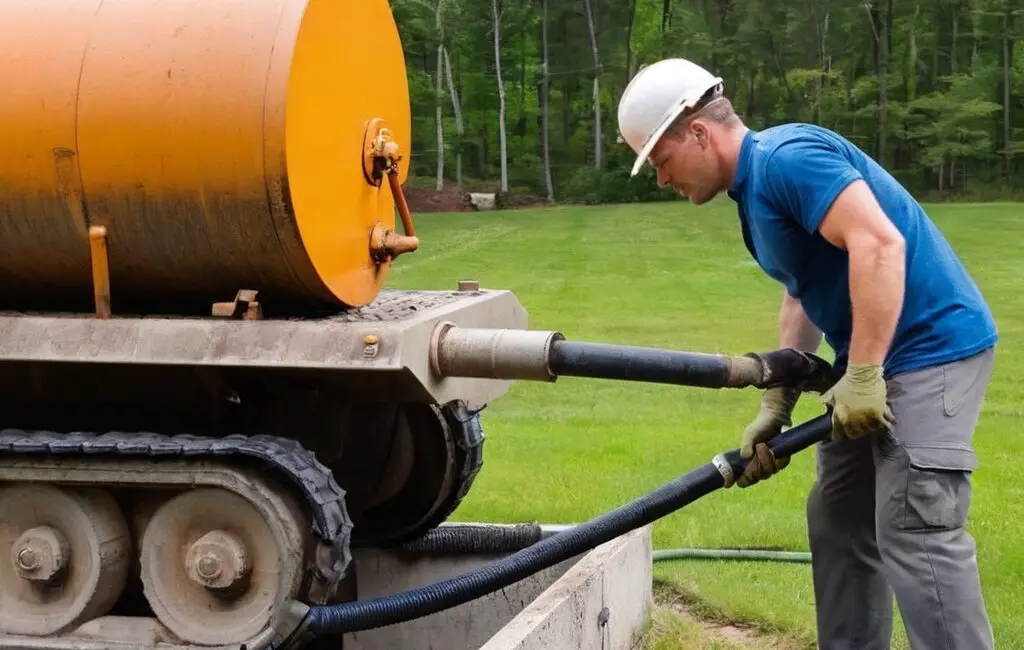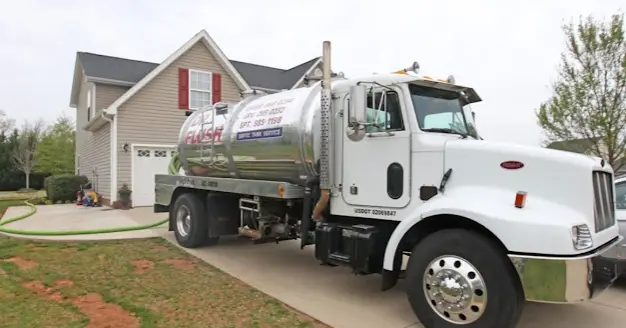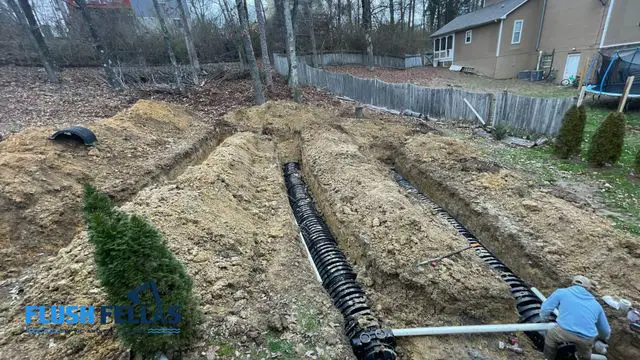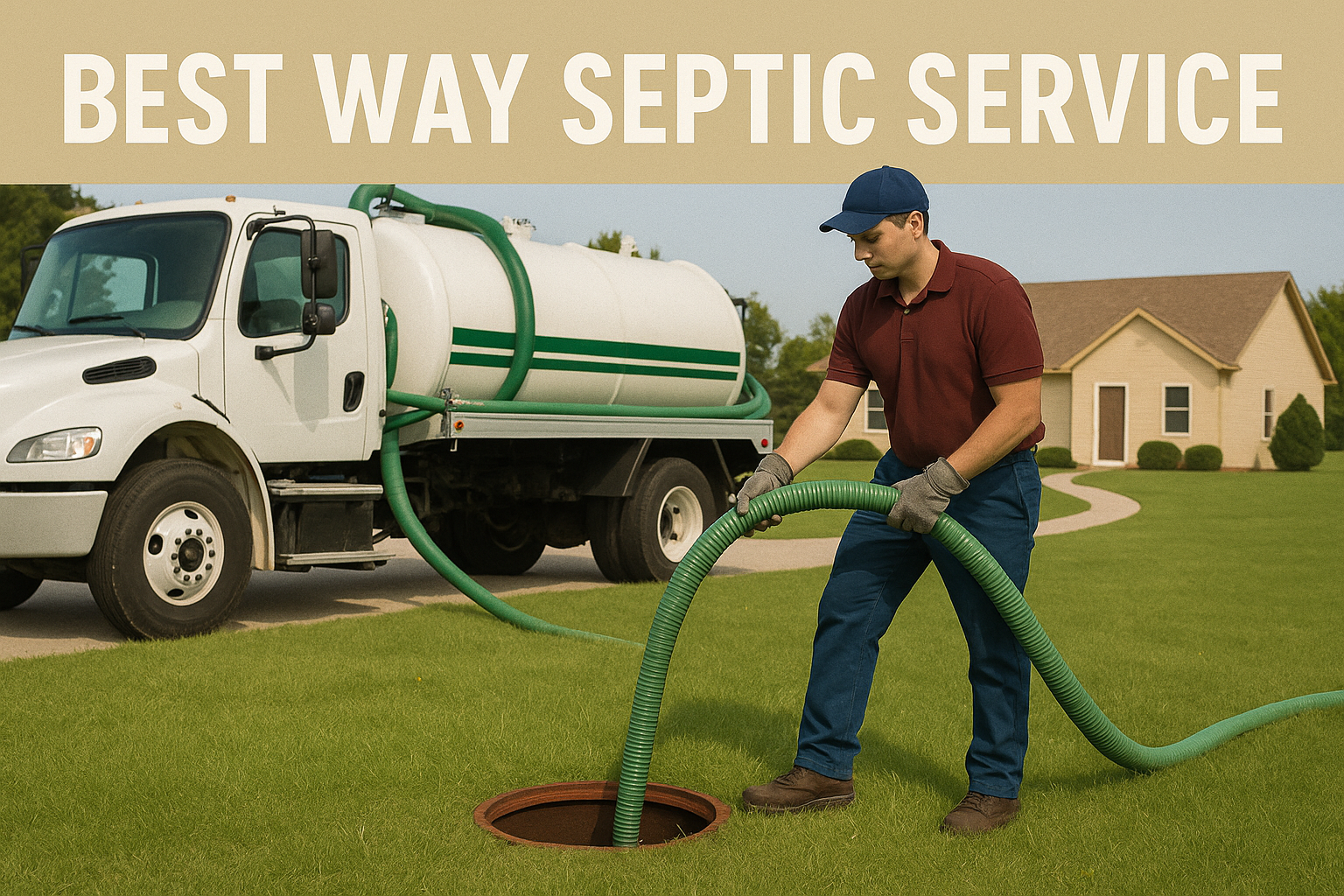The Complete Homeowner’s Guide to Septic Tank Care and Field Line Maintenance
Here’s something that might shock you: Right now, as you’re reading this, your septic system could be silently failing beneath your feet. Most homeowners have no idea that their “out of sight, out of mind” septic tank is actually a ticking time bomb that, when it finally explodes, can cost anywhere from $3,000 to $25,000 to fix. But here’s the good news – with just 30 minutes of reading and a few simple maintenance habits, you can avoid becoming another septic system horror story and keep your system running smoothly for decades to come.
Whether you’re a new homeowner trying to understand what lurks beneath your beautiful lawn, or you’ve been putting off septic maintenance for far too long, this comprehensive guide will transform you from septic-clueless to septic-confident. We’ll walk through everything from the basics of how your septic system actually works to advanced troubleshooting techniques that can save you thousands in professional repair costs.
Understanding Your Septic System: The Hidden Infrastructure Beneath Your Home
Before we dive into maintenance and troubleshooting, let’s demystify what’s actually happening under your property. Your septic system is essentially a mini wastewater treatment plant that handles all the water and waste from your home’s toilets, sinks, showers, and laundry.
The system consists of two main components: the septic tank and the drain field (also called field lines or leach field). When wastewater enters your septic tank, gravity does most of the heavy lifting. Solids sink to the bottom forming sludge, oils and grease float to the top creating scum, and the middle layer contains relatively clear liquid called effluent.
Expert Insight
“The biggest misconception homeowners have is thinking their septic system is maintenance-free. In reality, regular septic tank pumping every 3-5 years and basic preventive care can extend your system’s life from 15-20 years to 30-40 years. The small investment in maintenance pays dividends compared to premature system replacement.” – Dr. Sarah Mitchell, Environmental Engineering Specialist, University of Vermont
The magic happens through bacterial action. Beneficial bacteria in your septic tank break down organic matter, making the effluent safe enough to filter through your drain field. This effluent then percolates through layers of soil, which act as a natural filter before reaching groundwater.
Why Regular Septic System Maintenance Is Non-Negotiable
Think of septic maintenance like changing the oil in your car – skip it long enough, and you’ll face catastrophic failure. The Environmental Protection Agency emphasizes that proper septic system maintenance protects public health, preserves property values, and prevents environmental contamination.
Regular maintenance prevents solids from accumulating to dangerous levels. When sludge builds up excessively, it can flow into your drain field, clogging the soil and causing system failure. Once your drain field fails, you’re looking at extensive excavation, soil replacement, and potentially a complete system overhaul.
Beyond the financial implications, failed septic systems pose serious health risks. Untreated wastewater can contaminate drinking water sources and create unsanitary conditions around your home. The nitrogen and phosphorus in septic effluent can also trigger harmful algae blooms in nearby water bodies.
Recognizing the Warning Signs: When Your Septic System Cries for Help
Your septic system will give you plenty of warning signs before it fails completely – if you know what to look for. These early indicators can save you thousands in emergency repairs when addressed promptly.
Indoor Warning Signs
Slow draining fixtures are often the first sign of septic trouble. If multiple drains throughout your home are sluggish, especially those on the lowest level, your septic tank may be full or your field lines could be clogged. This is different from a single drain backup, which typically indicates a localized plumbing issue.
Gurgling sounds from your plumbing can indicate that air is trapped in your septic system, often due to a full tank or blocked vent. Sewage odors inside your home are never normal and usually signal that wastewater isn’t flowing properly through your system.
Water backing up in basement floor drains or the lowest fixtures in your home is a clear sign that your septic system can’t handle the volume of wastewater you’re producing. This backup often occurs during heavy usage periods or after significant rainfall.
Outdoor Red Flags
Standing water or consistently soggy ground over your drain field indicates that effluent isn’t properly infiltrating the soil. This ponding water often has a foul odor and can create unsanitary conditions in your yard.
Unusually lush, green grass growing over your septic tank or drain field might seem like a good thing, but it’s actually a warning sign. This verdant growth indicates that nutrients from your septic system are reaching the surface rather than being properly filtered through the soil.
Professional Perspective
“I’ve been servicing septic systems for over 20 years, and I can tell you that homeowners who ignore early warning signs always pay more in the long run. A $300 pumping service can prevent a $15,000 drain field replacement. The key is acting on these signs immediately, not waiting to see if they get worse.” – Mike Rodriguez, Licensed Septic Contractor, Rodriguez Environmental Services
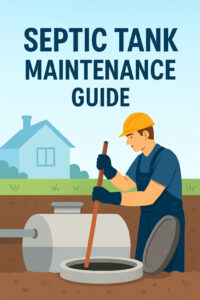
Strong sewage odors around your septic tank or drain field area indicate that gases are escaping from your system. These odors are not only unpleasant but can also pose health risks if hydrogen sulfide concentrations become too high.
Essential Septic Tank Maintenance: Your Action Plan for System Longevity
Proper septic tank maintenance isn’t complicated, but it does require consistency and attention to detail. Following these essential maintenance practices will keep your system functioning efficiently for decades.
Professional Inspection and Pumping Schedule
The cornerstone of septic maintenance is regular professional inspection and pumping. Most septic tanks need pumping every 3-5 years, but this frequency depends on several factors including tank size, household size, and water usage patterns.
A family of four with a 1,000-gallon septic tank should schedule pumping every 3-4 years. Larger households or smaller tanks require more frequent service. Keep detailed records of when your tank was last pumped and inspected – this information is invaluable for timing future maintenance and can be required for property sales.
During professional inspections, technicians check for structural damage, measure sludge and scum levels, inspect baffles and tees, and evaluate the overall system health. These inspections can identify minor issues before they become major problems.
Water Conservation Strategies
Excessive water usage can overwhelm your septic system, preventing proper treatment and potentially causing hydraulic overload. Implementing water conservation measures protects your system while reducing your utility bills.
High-efficiency fixtures make a significant difference in septic system performance. Low-flow toilets, aerated faucets, and efficient showerheads reduce the volume of water entering your system without sacrificing functionality.
Spread out laundry loads throughout the week rather than doing multiple loads in one day. This gives your septic system time to process wastewater properly and prevents hydraulic shock that can disrupt bacterial processes.
Fix leaky fixtures immediately. A running toilet can waste hundreds of gallons per day, overwhelming your septic system and causing premature failure. Even small drips add up over time and put unnecessary strain on your system.
Protecting Your System from Harmful Substances
What goes down your drains directly impacts your septic system’s health. Many common household products can kill beneficial bacteria or clog your system.
Never flush non-biodegradable items like feminine hygiene products, condoms, diapers, cat litter, or cigarette butts. These items don’t break down and can cause serious blockages in your system.
Limit the use of antibacterial soaps, bleach, and other harsh chemicals. While small amounts won’t harm your system, excessive use can disrupt the bacterial balance necessary for proper waste breakdown.
Cooking grease and oils should never go down your drains. These substances can solidify in your pipes and septic tank, creating stubborn clogs and interfering with bacterial processes. Instead, collect cooking grease in containers and dispose of it with your regular trash.
Maintenance Expert Tip
“One of the most effective maintenance practices I recommend is keeping a septic system diary. Track when you have the tank pumped, any problems you notice, and unusual circumstances like house guests or heavy rain. This record helps identify patterns and makes troubleshooting much easier when issues arise.” – Jennifer Clark, Certified Septic System Inspector, New England Environmental Solutions
Troubleshooting Field Line Problems: Diagnosing and Solving Drain Field Issues
Field line problems are among the most serious and expensive septic system issues you can face. Understanding how to identify and address drain field problems early can save you significant money and prevent environmental contamination.
Understanding Drain Field Function
Your drain field is where the final treatment of septic effluent occurs. Perforated pipes distribute partially treated wastewater from your septic tank across a bed of gravel and soil. This soil acts as a natural filter, removing harmful bacteria and nutrients before the water reaches groundwater.
The soil’s ability to filter and absorb effluent is critical to your system’s success. Different soil types have varying infiltration rates – sandy soils drain quickly but provide less filtration, while clay soils provide excellent filtration but may not absorb effluent fast enough.
Common Field Line Problems and Solutions
Hydraulic overload occurs when your drain field receives more effluent than it can handle. This can happen due to excessive water usage, a septic tank that needs pumping, or damaged distribution pipes. Signs include soggy ground over the drain field and slow-draining fixtures throughout your home.
To address hydraulic overload, first reduce water usage by fixing leaks and implementing conservation measures. If the problem persists, have your septic tank inspected and pumped if necessary. Sometimes installing a distribution box or adding additional drain field lines can resolve capacity issues.
Biomat formation is a natural process where bacteria and organic matter create a thin layer in the soil around drain field pipes. While some biomat formation is normal and beneficial, excessive buildup can prevent proper infiltration.
Preventing excessive biomat formation requires regular septic tank pumping to prevent solids from reaching the drain field. If biomat clogging has already occurred, resting the drain field (if you have multiple fields) or biological treatments may help restore proper function.
Advanced Troubleshooting Techniques
When basic maintenance doesn’t resolve field line problems, more advanced diagnostic techniques may be necessary. Percolation testing can determine if your soil’s infiltration rate has changed since installation, while video inspection of distribution pipes can identify breaks or blockages.
Soil compaction from vehicles or heavy equipment can severely damage drain field performance. Always keep heavy machinery away from your drain field area, and avoid walking or driving on it when the soil is wet and more susceptible to compaction.
Field Specialist Advice
“Most drain field failures I see could have been prevented with proper septic tank maintenance. When homeowners skip pumping for 7-10 years, solids inevitably reach the drain field and cause permanent damage. The few hundred dollars spent on regular pumping can prevent $20,000+ in drain field replacement costs.” – Robert Thompson, Soil Scientist and Septic System Designer, Thompson Environmental Consulting
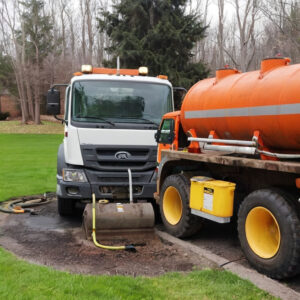 Preventing and Clearing Septic System Clogs
Preventing and Clearing Septic System Clogs
Clogs in your septic system can occur at various points, from the inlet pipe to the distribution box to individual field lines. Understanding where clogs typically form and how to prevent them will keep your system flowing smoothly.
Common Clog Locations and Causes
Inlet pipe clogs often result from flushed items that don’t belong in septic systems. Feminine hygiene products, baby wipes (even those labeled “flushable”), and excessive toilet paper can create blockages before waste even reaches your septic tank.
Outlet baffle clogs typically occur when scum and floating debris block the outlet pipe. This prevents effluent from flowing to the drain field and can cause backups throughout your home. Regular pumping prevents scum accumulation that leads to these clogs.
Distribution box clogs happen when solids from an over-full septic tank reach the distribution system. These clogs can cause uneven distribution of effluent to field lines, leading to system failure in sections of your drain field.
Prevention Strategies
The best clog prevention strategy is controlling what enters your septic system. Install drain screens in sinks to catch food particles and hair before they enter your system. These simple devices can prevent many common clogs.
Educate all household members about proper septic system use. Post reminders near toilets about what shouldn’t be flushed, and keep a trash can in every bathroom for items that don’t belong in your septic system.
Regular bacterial treatments can help maintain the biological balance in your septic tank, potentially preventing some types of clogs. However, these treatments are supplements to, not replacements for, regular pumping and proper usage habits.
Safe Clog Removal Techniques
When clogs do occur, resist the temptation to use chemical drain cleaners. These products can kill beneficial bacteria in your septic system and may not be effective against septic-related clogs anyway.
For minor clogs in household drains, try mechanical methods first. A plunger or drain snake can often clear blockages without introducing harmful chemicals to your system. Hot water flushes can also help dissolve grease-based clogs.
If multiple fixtures are backing up simultaneously, the clog is likely in your septic system itself rather than household plumbing. These clogs require professional attention and should not be addressed with DIY methods.
The Critical Role of Bacteria in Septic System Health
Your septic system is essentially a carefully balanced ecosystem where beneficial bacteria do the heavy lifting of breaking down waste. Understanding and protecting this bacterial community is essential for long-term system health.
How Septic Bacteria Work
Two types of bacteria work in your septic tank: aerobic bacteria that require oxygen and anaerobic bacteria that work in oxygen-free environments. The anaerobic bacteria in the lower portion of your tank break down organic solids, while aerobic bacteria near the surface help process floating materials.
These bacteria produce enzymes that break down proteins, fats, and carbohydrates in wastewater. This biological process reduces solid waste volume and creates effluent that’s safe for soil infiltration in your drain field.
The bacterial community in your septic tank is remarkably resilient, but it can be disrupted by harsh chemicals, antibiotics, or sudden changes in waste composition. When bacterial populations crash, solid waste accumulates faster and system performance declines.
Protecting Your Bacterial Ecosystem
Avoiding antibacterial products is one of the most important steps in protecting septic bacteria. While small amounts of these products won’t cause problems, regular use of antibacterial soaps, cleaners, and sanitizers can gradually reduce bacterial populations.
Prescription antibiotics can also impact septic bacteria, though normal medical use typically doesn’t cause long-term problems. If you’re on extended antibiotic treatment, consider using bacterial supplements to help maintain your septic system’s biological balance.
Maintaining proper pH levels in your septic tank supports bacterial health. Most household waste naturally creates suitable pH conditions, but excessive use of acidic or alkaline products can create hostile environments for beneficial bacteria.
Microbiologist’s Insight
“The bacterial communities in septic systems are incredibly sophisticated and resilient. They can handle normal household chemicals and temporary disruptions, but they need stable conditions to thrive. The biggest threats I see are excessive bleach use and water softener backwash, both of which can create hostile environments for beneficial bacteria.” – Dr. Amanda Foster, Environmental Microbiologist, State University Research Center
When to Consider Bacterial Supplements
Bacterial supplements can be helpful in specific situations, such as after antibiotic treatment, following system shock from chemicals, or when restarting a system after extended non-use. However, these products are not magic bullets and won’t compensate for poor maintenance practices.
Choose bacterial supplements specifically designed for septic systems rather than general-purpose products. Look for products containing multiple bacterial strains and enzymes that target different types of waste materials.
Remember that bacterial supplements work slowly – don’t expect immediate results. It can take several weeks for new bacterial populations to establish and begin showing measurable improvements in system performance.
Seasonal Septic System Maintenance: Year-Round Care Strategies
Different seasons present unique challenges and opportunities for septic system care. Developing seasonal maintenance routines helps ensure your system performs optimally throughout the year.
Spring Septic System Preparation
Spring is an ideal time for septic system inspection after winter’s harsh conditions. Check for any visible damage around your septic tank and drain field areas, looking for signs of frost damage, settling, or erosion that may have occurred during winter months.
Spring cleaning often involves increased chemical use throughout the home. Be mindful of how much bleach, ammonia, and other harsh cleaners you’re using, as excessive amounts can disrupt your septic system’s bacterial balance.
If you haven’t had your septic tank pumped recently, spring is an excellent time to schedule this service. Getting ahead of the busy summer season ensures you can schedule at your convenience rather than in an emergency situation.
Summer System Considerations
Summer typically brings increased water usage due to guests, swimming pools, and lawn irrigation. Monitor your water consumption and spread usage throughout the day when possible to avoid overwhelming your septic system.
Landscaping activities during summer require special attention to your septic system location. Avoid planting trees or large shrubs too close to your septic tank or drain field, as root intrusion can cause serious damage over time.
Pool and spa maintenance chemicals should never be discharged into your septic system. These chemicals can kill beneficial bacteria and disrupt system function. Always discharge pool water to areas away from your septic system components.
Fall and Winter Protection
Fall preparation focuses on protecting your septic system from winter weather. Ensure adequate insulation over your septic tank by maintaining a layer of soil and avoiding compaction from vehicles or heavy equipment.
Clear gutters and downspouts to direct roof runoff away from your septic system. Excessive surface water can saturate your drain field and prevent proper effluent infiltration.
Winter septic system care requires special attention in freezing climates. Maintain consistent water usage to prevent pipes from freezing, and avoid using antifreeze or other chemicals that can harm your system’s bacteria.
Seasonal Maintenance Expert
“Seasonal maintenance isn’t just about protecting your septic system from weather – it’s about adapting your usage patterns to seasonal changes. Summer guests and holiday cooking can stress your system if you’re not prepared. I always recommend homeowners plan ahead for high-usage periods and adjust their maintenance schedules accordingly.” – Lisa Chen, Certified Septic System Maintenance Specialist, Pacific Northwest Environmental Services
Knowing When to Call Professionals: Signs You Need Expert Help
While homeowner maintenance is crucial for septic system health, some situations require professional expertise. Recognizing when to call for help can prevent minor issues from becoming major disasters.
Emergency Situations Requiring Immediate Professional Attention
Sewage backing up into your home is a health emergency that requires immediate professional response. This situation poses serious health risks and indicates complete system failure or severe blockage that cannot be addressed with DIY methods.
Strong sewage odors throughout your home, especially if accompanied by other symptoms, suggest dangerous gas buildup or system failure. These situations can pose health risks and require immediate professional evaluation.
Visible sewage or effluent on the ground surface around your septic system indicates system failure and potential environmental contamination. Professional assessment and remediation are necessary to protect public health and comply with environmental regulations.
Routine Professional Services
Regular septic tank pumping should always be performed by licensed professionals with proper equipment and disposal capabilities. Attempting DIY pumping is dangerous and typically illegal in most jurisdictions.
System inspections require specialized knowledge and equipment to properly assess septic tank condition, measure sludge levels, and evaluate drain field performance. Professional inspectors can identify problems that homeowners might miss.
Permit applications and regulatory compliance often require professional involvement. Many jurisdictions require licensed professionals to perform certain septic system work and sign off on permits and inspections.
Choosing the Right Septic Professional
Verify licensing and insurance before hiring any septic system contractor. Licensed professionals have demonstrated knowledge of local codes and regulations, while insurance protects you from liability during service calls.
Look for contractors with specific experience in your type of septic system and local soil conditions. Different system types and geographic areas
